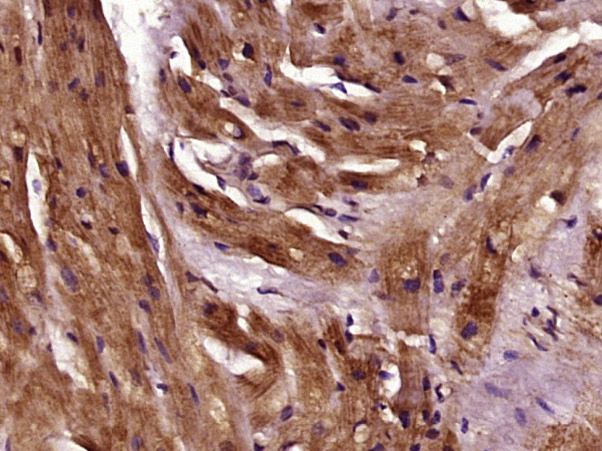
Rabbit Anti-Tropomyosin antibody
Tropomyosin 1 (alpha); Alpha tropomyosin; Alpha-tropomyosin; C15orf13; cardiomyopathy, hypertrophic 3; CMD1Y; CMH3; HTM alpha; sarcomeric tropomyosin kappa; TMSA; TPM1; TPM1_HUMAN; Tropomyosin 1; Tropomyosin1; Tropomyosin alpha 1 chain; Tropomyosin alpha-
View History [Clear]
Details
Product Name Tropomyosin Chinese Name 原肌球蛋白1抗体 Alias Tropomyosin 1 (alpha); Alpha tropomyosin; Alpha-tropomyosin; C15orf13; cardiomyopathy, hypertrophic 3; CMD1Y; CMH3; HTM alpha; sarcomeric tropomyosin kappa; TMSA; TPM1; TPM1_HUMAN; Tropomyosin 1; Tropomyosin1; Tropomyosin alpha 1 chain; Tropomyosin alpha-1 chain; Tropomyosin-1; Tropomyosin α; Tropomyosin-α; Tropomyosinα. Research Area Cardiovascular Signal transduction Cytoskeleton Extracellular matrix Immunogen Species Rabbit Clonality Polyclonal React Species Human, (predicted: Mouse, Rat, Dog, Zebrafish, Sheep, ) Applications ELISA=1:5000-10000 IHC-P=1:100-500 IHC-F=1:100-500 ICC=1:100-500 IF=1:100-500 (Paraffin sections need antigen repair)
not yet tested in other applications.
optimal dilutions/concentrations should be determined by the end user.Theoretical molecular weight 33kDa Cellular localization cytoplasmic Form Liquid Concentration 1mg/ml immunogen KLH conjugated synthetic peptide derived from human Tropomyosin: 201-284/284 Lsotype IgG Purification affinity purified by Protein A Buffer Solution 0.01M TBS(pH7.4) with 1% BSA, 0.03% Proclin300 and 50% Glycerol. Storage Shipped at 4℃. Store at -20 °C for one year. Avoid repeated freeze/thaw cycles. Attention This product as supplied is intended for research use only, not for use in human, therapeutic or diagnostic applications. PubMed PubMed Product Detail Binds to actin filaments in muscle and non-muscle cells. Plays a central role, in association with the troponin complex, in the calcium dependent regulation of vertebrate striated muscle contraction. Smooth muscle contraction is regulated by interaction with caldesmon. In non-muscle cells is implicated in stabilizing cytoskeleton actin filaments.
Function:
Binds to actin filaments in muscle and non-muscle cells. Plays a central role, in association with the troponin complex, in the calcium dependent regulation of vertebrate striated muscle contraction. Smooth muscle contraction is regulated by interaction with caldesmon. In non-muscle cells is implicated in stabilizing cytoskeleton actin filaments.
Subunit:
Heterodimer of an alpha and a beta chain (By similarity). Interacts with HRG (via the HRR domain); the interaction contributes to the antiangiogenic properties of the histidine/proline-rich region (HRR) of HRG.
Subcellular Location:
Cytoplasm, cytoskeleton.
Tissue Specificity:
Detected in primary breast cancer tissues but undetectable in normal breast tissues in Sudanese patients. Isoform 1 is expressed in adult and fetal skeletal muscle and cardiac tissues, with higher expression levels in the cardiac tissues. Isoform 10 is expressed in adult and fetal cardiac tissues, but not in skeletal muscle.
Post-translational modifications:
Phosphorylated at Ser-283 by DAPK1 in response to oxidative stress and this phosphorylation enhances stress fiber formation in endothelial cells.
DISEASE:
Defects in TPM1 are the cause of familial hypertrophic cardiomyopathy type 3 (CMH3) [MIM:115196]. Familial hypertrophic cardiomyopathy is a hereditary heart disorder characterized by ventricular hypertrophy, which is usually asymmetric and often involves the interventricular septum. The symptoms include dyspnea, syncope, collapse, palpitations, and chest pain. They can be readily provoked by exercise. The disorder has inter- and intrafamilial variability ranging from benign to malignant forms with high risk of cardiac failure and sudden cardiac death.
Defects in TPM1 are the cause of cardiomyopathy dilated type 1Y (CMD1Y) [MIM:611878]. Dilated cardiomyopathy is a disorder characterized by ventricular dilation and impaired systolic function, resulting in congestive heart failure and arrhythmia. Patients are at risk of premature death.
Similarity:
Belongs to the tropomyosin family.
SWISS:
P09493
Gene ID:
7168
Database links:Entrez Gene: 7168 Human
Entrez Gene: 22003 Mouse
Entrez Gene: 30324 Zebrafish
Omim: 191010 Human
SwissProt: P09493 Human
SwissProt: P58771 Mouse
SwissProt: P13104 Zebrafish
Unigene: 133892 Human
Unigene: 121878 Mouse
Unigene: 87540 Rat
Product Picture
References (0)
No References
Bought notes(bought amounts latest0)
No one bought this product
User Comment(Total0User Comment Num)
- No comment



 +86 571 56623320
+86 571 56623320
 +86 18668110335
+86 18668110335

